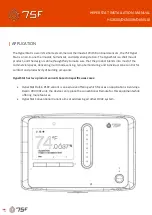
FläktGroup
DC_9971GB 20201028_R2
Specifications are subject to alteration without notice.
Fire damper ETPR-E-1 - Instructions for Installation, Operation and Maintenance
3
INSTALLATION AND MAINTENANCE
INSTALLATION
To secure the performance and operation of the fire damper, it is ne-
cessary to do the installation according to these instructions and local
regulations.
Fire damper ETPR-E-1 can be fitted with either to horizontal or vertical
ducting. Max. velocity of air flow through the damper is 15 m/s, and
operation in not dependent on the air flow direction.
MAINTENANCE
The function testing interval is always determined separately for each
building, but testing must be carried out at least twice a year according
to product standard EN 15650:2010 (see example of check list beside).
WARNING! Never put your hands inside the damper while it is closing.
Clean the fire damper by means of a vacuum cleaner. Avoid chemical
cleaning agents.
Fig. 4. Installation of fire damper into lightweight plasterboard building elements (gyp-
sum board or similar), wall thickness
≥
116 mm.
The blade shaft can be placed in any position.
1. Fire damper
2. Fastening into concrete or masonry building element:
steel anchor
≥
M6, 4 pcs
Fastening into lightweight plasterboard building element:
steel anchors suited for boards
≥
M6, 4 pcs
Fig. 3. Installation of fire damper into building elements (walls and intermediate
floors) made of concrete or masonry, construction thickness
≥
110 mm.
The blade shaft can be placed in any position.
3. Grouting, gypsum or concrete based, 25-35 mm thick
4. Mineral wool, min. density 40 kg/m
3
5. Fire resistant mass
The body has to be fixed firmly into building element. Damper has a
factoryfitted installation plate for mounting. Fire damper is installed into
building element according to installation drawings below.
Fire damper has to be fitted into ducting so, that it is easy to inspect
and clean.
Min. inlet size
D + 50 mm
3
2
1
Inlet size
D + 10 mm
5
2
4
1
MAINTENANCE CHECK LIST
Fire damper reference
Date of inspection
Check actuator wiring for damage (where applicable)
Check end-switch wiring for damage (where applicable)
Check fire damper cleanliness and clean where necessary
Check the condition of blades and seals, rectify and report where neces-
sary
Confirm the safety closure operation of the fire damper according to the
manufacturer’s instructions
Confirm operation of damper to OPEN and CLOSE by use of the control
system and physical observation of the fire damper, rectify and report
where necessary
Confirm operation of OPEN and CLOSED end-switches, rectify and report
where necessary
Confirm that the fire damper fullfills its function as a part of the control
system (where applicable)
Confirm that the fire damper is left in its normal working position
NOTE! A fire damper is usually part of a system. As this is the case, the
whole system should be checked as governed by the operation and
maintenance requirements for the system.









